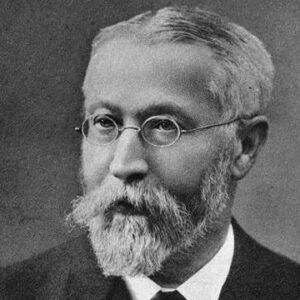Karl Ferdinand Braun was a German physicist and inventor who won the Nobel Prize for Physics in 1909. He shared the prize with Guglielmo Marconi, who was also an inventor and scientist. He was given the Nobel Prize for his work on the technologies that make TV and radio work. At a young age, he became interested in trying out wireless telegraphy. Marconi’s wireless technology could only go about 15 kilometers. The antenna was hooked up straight to the transmitter’s power circuit. Braun made an antenna that could make wireless transmissions possible over many more kilometers of distance. He is also well-known for making the Cathode Ray Tube, or CRT, which was later used to make TV screens and computer monitors. He came up with ways to change the voltage to control the cathode rays and get a pattern on the fluorescent screen that had not been possible before. He also came up with the oscilloscope, which is a tool used in electrical and electronic labs to measure different electrical parameters. He also made the first “cat’s whisker diode,” which led to the development of radios with crystal receivers.
Early years and childhood
Karl Ferdinand Braun was born on June 6, 1850 in Fulda, Germany to Johan Konrad Braun and Franziska Gohring Braun. He was his parents’ fourth child.
He went to the Fulda grammar school for his first schooling.
After high school, he went to the “University of Marburg” to study chemistry and math.
In 1872, he got his doctorate in physics from the “University of Berlin.”
After that, he was a graduate assistant at the University of Wurzburg.
Karl Braun’s Career
Karl Ferdinand Braun found out in 1874 that point-contact semiconductors could change alternating currents into direct currents.
In 1874, he joined the teaching staff at Leipzig’s “St. Thomas Gymnasium.”
In 1877, Marburg University made him an “Extraordinary Professor of Theoretical Physics.”
In 1880, he also became an “Extraordinary Professor of Physics” at Strasbourg University.
In 1883, he started teaching physics at the “Polytechnic School” in Karlsruhe.
In 1885, the “University of Tubingen” asked him to build a new “Physics Institute.”
In 1895, he went back to Strasbourg to become a professor of physics at the “University of Strasbourg” and the head of the university’s “Physical Institute.”
In 1897, he made the first Cathode Ray Tube (CRT) and the first CRT oscilloscope. CRTs were used in TVs and computer monitors for almost a century, until they were replaced in the 21st century by flat-screen LCD, LED, and finally Plasma screens.
In 1897, he joined a group of scientists who were working to improve radio and wireless technology.
In 1898, he decided that he would do everything he could to solve the problems with wireless telegraphy. He worked on this problem for the next few years.
In 1898, he found the “cat’s whisker diode” or crystal rectifier, which turned alternating current into direct current. This made it possible for wireless devices to work from farther away.
In 1899, he tried to get many patents for his ideas about wireless telegraphy.
When he was at Strasbourg University, he began to try out wireless telegraphy.
Soon, he was able to use wireless telegraphy to connect to the city of Mutzig, which was 42 kilometers away. On September 24, 1900, he was able to set up wireless telegraphy between Cuxhaven on the North Sea coast and the island of Heligoland, which was about 62 kilometers away. During this time, he also made it possible for Cuxhaven and small boats on the Elbe River to talk to each other wirelessly.
He helped make the first wireless transmission across the Atlantic Ocean possible in 1901, which led to the start of the wireless telegraphy business.
With the help of the “inclined beam antenna,” he was able to get messages in 1902.
In 1905, he came up with the idea of the “phased array antenna.” This was a set of three antennas placed one behind the other to send a signal in a certain direction. Later, this technology was used to make the radar and the smart antennas.
Before the First World War, he was called to the US in 1914 to testify in favor of the wireless station run by the “Atlantic Communication Company” in Sayville, New York, against a lawsuit filed by the “American Marconi Corporation,” which was owned by the British Government.
He couldn’t go back to Germany because the First World War had already started and the US had joined it. He was free to move around Brooklyn, New York, as he pleased. He couldn’t do any more experiments because New York didn’t have any labs for him to use. He lived with one of his sons, Konrad, until he died.
Works of note
His patented ideas have been put into books called “Electro Telegraphy by Means of Condensers and Induction Coils” and “Wireless Electro Transmission of Signals over Surfaces.”
Awards & Achievements
Karl Ferdinand Braun won the Nobel Prize in Physics in 1909 for his groundbreaking work in wireless telegraphy and television.
Personal History and Legacies
In 1883, he married Amelie Buhler. At the time, he was working at the Karlsruhe Polytechnic school.
From this marriage, he had two boys and two girls.
Before the end of the First World War, Karl Ferdinand Braun died on April 20, 1918, in Brooklyn, New York, in the United States.
Estimated Net worth
Unknown.


